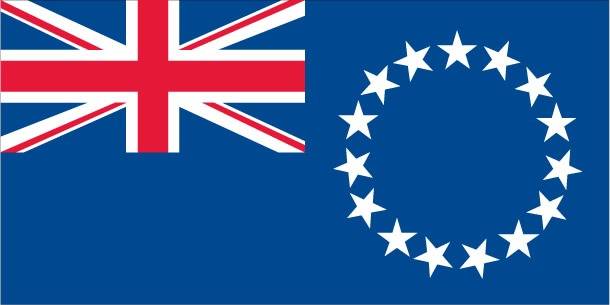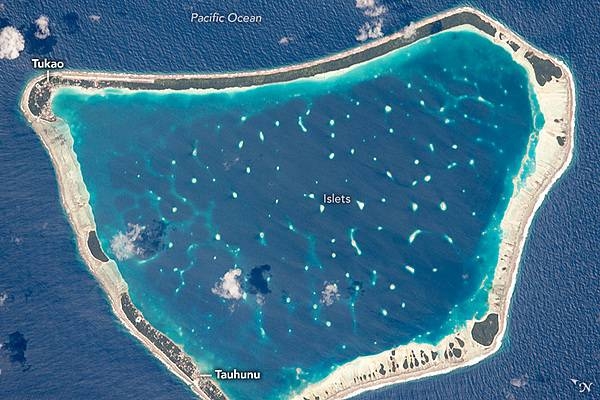44 Cook Islands (partly NZ)

Blue with the flag of the UK in the upper hoist-side quadrant and a large circle of 15 white five-pointed stars (one for every island) centered in the outer half of the flag.
Flag courtesy of the CIA World Factbook

Map courtesy of the CIA World Factbook

Manihiki is one of the larger islands (10.5-km (6.5-mi) long) in the remote Cook Island chain; with its fringing coral reef and central lagoon, it has the hallmarks of a classic atoll. The coral lives in the warm, shallow waters that appear as the light blue zones around the main coastline and the numerous small islets within the lagoon. Most of the main atoll is made of sandy beaches without vegetation; it appears white or cream due to dead coral broken up by waves. Soils develop on the highest parts of these beaches, supporting dense stands of dark green trees. A few clouds cast shadows on the water. Two small towns – Tauhunu and Tukao – appear as clusters of small bright patches etched into the forest. Aircraft land at the runway in Tukao after flying from New Zealand, 3,650 km (2,270 mi) to the southwest. Tourism is the main economic activity on the atoll, with diving in the lagoon and fishing in the waters outside it as the major attractions. Manihiki also produces rare black pearls, which are harvested from the local species of oyster.
Photo courtesy of the CIA World Factbook
Government
According to Britannica, the Cook Islands is a self-governing state. Although New Zealand is nominally responsible for defense and for external affairs, the Cook Islands has nevertheless independently established diplomatic relations and entered into international treaties. The formal head of state is the British monarch, represented by an appointed delegate to the islands; the government of New Zealand also appoints a representative, known as the high commissioner. Day-to-day executive power is vested in a cabinet headed by the prime minister and appointed by the islands’ unicameral Parliament. Parliamentary elections, with universal adult suffrage, are held every four years. The constitution, adopted in 1965, has been amended several times. A council of hereditary leaders, the House of Ariki (High Chiefs), advises the government on traditional matters of landownership, custom, and the like. The two main political parties are the Cook Islands Party and the Democratic Party.
Cook Islands Ministry of Transport
The Cook Islands Ministry of Transport is a Government department in a country dependent upon maritime and aviation transport, both nationally and internationally. The Ministry of Transport is charged with carrying out all of the functions of maritime and aviation administration necessary under international and national law in a rapidly changing and developing transport environment.
In addition, the Cook Islands Meteorological Service is a division of the Ministry of Transport. The Met Service provides the latest weather updates, forecasts and warnings for the Cook Islands.
The Offices of the Ministry of Transport are also responsible for administering the liquor licensing regime and secretariat to the licensing of public transport such as taxi, buses and tourism transfers transportation.
Pacific Aviation Safety Office (PASO)
The Pacific Aviation Safety Office (PASO) is an international organization providing quality aviation safety and security service for Member States in the Pacific.
PASO is the sole international organization responsible for regional regulatory aviation safety oversight service for the 10 Pacific States who are signatories to the Pacific Islands Civil Aviation Safety and Security Treaty (PICASST).
The current PICASST signatories are the Pacific nations of Cook Islands, Kiribati, Nauru, Niue, Papua New Guinea, Samoa, Solomon Islands, Tonga, Tuvalu, and Vanuatu. Associate Members of PASO are Australia, Fiji and New Zealand. Government representatives from these nations make up the PASO Council.
Airspace
SkyVector – Google Maps – ADS-B Exchange
ICAO countries publish an Aeronautical Information Publication (AIP). This document is divided into three parts: General (GEN), En Route (ENR) and Aerodromes (AD). ENR 1.4 details the types of airspace classes they chose to adopt from classes A through G.
Drone Regulations
Ministry of Transport (MOT) – Drone laws
Advanced Air Mobility (AAM) Regulations & Policies
None found by the author.
However, should you, the reader, happen to stumble across something to the contrary, please email the author at FISHE5CA@erau.edu and you may be mentioned in the ACKNOWLEDGEMENTS section of this book by way of thanks for contributing to this free eBook!
Advanced Air Mobility (AAM) News
None found by the author.
However, should you, the reader, happen to stumble across something to the contrary, please email the author at FISHE5CA@erau.edu and you may be mentioned in the ACKNOWLEDGEMENTS section of this book by way of thanks for contributing to this free eBook!
Short Essay Questions
Scenario-Based Question
You have been hired by a Drone Startup Company. Your boss has immediately assigned this job to you.
They need you to prepare a one-page memo detailing the legalities of using a drone in the Cook Islands.
They need you to mention any national laws and local ordinances.
They specifically want to know what airspace (insert pictures) you will be operating in and whether or not you need an airspace authorization.
Does it matter whether or not you are a citizen of the country?
Lastly, there is a bonus for you if, as you scroll through this chapter, you find any typos or broken links!
Short Essay Questions
- What are the drone categories?
- How is registration addressed?
- How is remote ID addressed?
- What are the model aircraft rules?
- What are the commercial drone rules?
- Are there waivers or exemptions to the rules? If so, for what?
- Would you share a link to an interactive airspace map?
- How is BVLOS addressed?
- How can you fly drones at night?
- How can you fly drones over people?
- Where do you find drone NOTAMs?
- What are the rules for drone maintenance?
- What are the rules for an SMS program?
- What are some unique rules not mentioned above?
- What are the C-UAS rules?
- What are the AAM rules?

